Table of Contents
Ever had one of those ‘everything’s perfect’ days that suddenly nose-dives into chaos, thanks to a pesky leaky pipe? We’ve all been there! So, what’s our go-to move? Picking up the toolbox instead of the phone.
But here’s the catch – no warranty, no quality guarantee, and no reliability assurance! Sometimes, even the tiniest household hiccups require a bit more expertise.
Picture this: You’re told it’s just the pipe that’s the problem, but a little later down the road, BAM! There’s a plumbing apocalypse lurking. Nobody’s got time for extra charges and an endless hassle, right?
That’s when the lightbulb moment hits, and you realize the importance of taking matters into your own hands with housekeeping or regular home maintenance and check-ups. Admit it, this is when you dive headfirst into DIY tutorials and watch YouTube videos on fixing things around the house!
Why Home Maintenance Is Crucial for Homeowners
Owning a home is a significant investment and a source of pride, but it also comes with a set of responsibilities that renting does not entail.
Unlike renting, where landlords typically handle maintenance and repairs, homeowners are solely responsible for the upkeep of their properties. This includes not only keeping the home clean and aesthetically pleasing but also ensuring that it is in good working condition.
Cost-Savings
Home maintenance is more than just a matter of appearances; it plays a crucial role in the long-term well-being of your home and your finances.
Regular maintenance and housekeeping services help to preserve your home’s value and extend the lifespan of your appliances and systems. This translates to getting the most value out of your investment over time.
One of the primary benefits of proactive home maintenance is cost savings. While it may seem like an expense upfront, it prevents the need for costly repairs down the road. Neglected maintenance can lead to more significant problems that require expensive fixes.
By addressing issues early and keeping your home in good condition, you can avoid unexpected and budget-draining repair bills.
Home maintenance is a vital aspect of homeownership that goes beyond aesthetics. It is an investment in the longevity and value of your home, as well as a means of avoiding costly repairs.
By staying proactive in maintaining your home, you can enjoy the benefits of a well-maintained, comfortable, and financially sound living space.
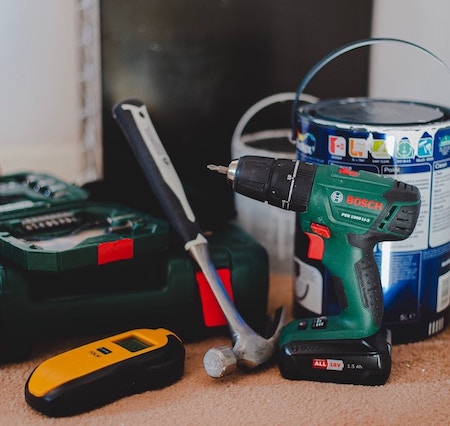
Handy Home Tips on Home Maintenance Timing and Tasks
Get the lowdown on housekeeping and home maintenance timing and tasks with these handy home tips.
Daily/Weekly
Daily and weekly home maintenance work is vital because it helps you stay on top of small issues before they escalate into major problems. By addressing these tasks regularly, you ensure that your home remains safe, comfortable, and in excellent condition, saving you time and money in the long run.
Cleaning

Vacuum Cleaning or Sweeping Floors
Cleaning your floors is an essential aspect of home maintenance, and it begins with either vacuuming or sweeping.
To get started, make sure the floor is clear of any obstacles like toys or shoes. If you’re using a vacuum cleaner, adjust the settings to match your floor type, whether it’s carpet, hardwood, or something else.
As you work through the room, move furniture if necessary, and maintain a systematic approach, preferably in straight lines, to ensure thorough coverage.
High-traffic areas and the spaces under furniture are prime areas to focus on during your cleaning routine. These spots tend to collect more dirt and debris, so giving them extra attention ensures a cleaner home.
Once you’ve completed the task, don’t forget to empty the vacuum bag or canister if you used a vacuum cleaner. Properly storing your cleaning equipment is equally important to keep it in good working condition for future use.
By following these steps, you can efficiently and effectively clean your floors, contributing to a clean and welcoming living space.
Wipe Down Kitchen Countertops
When it’s time to freshen up your kitchen countertops, a few simple steps can make a noticeable difference. Start by clearing the countertops of any items, such as dishes or small appliances, to have a clean working surface.
Next, use a damp cloth or sponge to wipe away any crumbs and spills that may have accumulated. For stubborn stains, a mixture of water and mild dish soap can be highly effective in removing them.
To finish the task, dry the countertops with a clean, dry cloth to prevent streaks and maintain a polished appearance. Once your countertops are spotless and dry, return any items you had removed earlier to their rightful places.
This routine not only keeps your kitchen looking its best but also promotes a clean and hygienic food preparation environment.
Effective Trash Disposal
Properly managing your household trash is essential for maintaining cleanliness and hygiene. Begin by securely tying up the trash bag to prevent any potential spills or leaks.
Then, remove the bag from the trash bin and replace it with a fresh one for future use. If you notice that the bin itself is dirty, take a moment to give it a quick wipe with a disinfectant or soapy water to ensure it remains clean and odor-free.
Additionally, remember to extend your trash disposal routine to other rooms in your home, such as the bathroom or bedroom, as necessary.
Lastly, dispose of the collected trash in your designated garbage or recycling containers, adhering to your local waste disposal guidelines.
By following these simple steps, you not only maintain a clean living environment but also contribute to responsible waste management.
Efficient Dishwashing and Kitchen Cleaning
Efficiently tackling the task of dishwashing and kitchen cleaning is essential for maintaining a tidy and functional cooking space.
To begin, scrape any food scraps into the trash or compost bin to prevent clogging your sink. Fill the sink with warm, soapy water, and if dishes have stubborn, stuck-on food, let them soak for a bit to facilitate easier cleaning.
Wash dishes, glasses, and utensils using a scrubber or sponge as needed, ensuring they are thoroughly cleaned. Rinse each item under hot water to remove any soap residue, and then allow them to air dry in a dish rack or use a clean towel.
Moving beyond the dishes, don’t forget to clean kitchen appliances like the microwave or stove. Simply wipe down the surfaces with a damp cloth and a suitable cleaner to remove any grease or spills.
Lastly, before wrapping up your kitchen cleaning routine, give the sink and faucet a good cleaning to ensure overall hygiene. This approach keeps your kitchen sparkling clean and ready for your culinary adventures.
Creating a Well-Made Bed
Achieving a well-made bed not only adds a touch of tidiness to your bedroom but also offers a welcoming place to rest. To start, straighten out the sheets and blankets, ensuring they lie flat and even. Then, fluff and arrange your pillows to create a comfortable and inviting arrangement.
Next, take a moment to smooth out any wrinkles or creases in the bedding, leaving it looking neat and pristine. Tuck in the sides and foot of the top sheet and blankets neatly for a polished appearance. If you have decorative pillows or throws, arrange them thoughtfully to complement the overall aesthetic.
Finally, step back and admire your nicely made bed. This small but impactful daily ritual adds a sense of order and comfort to your bedroom, inviting you to unwind and enjoy a peaceful night’s sleep.
Monthly
Monthly home maintenance and housekeeping are essential to prevent the buildup of dirt, allergens, and grime that can affect indoor air quality and your family’s health. Additionally, regular upkeep ensures that your home remains comfortable, safe, and inviting, creating a harmonious living environment.
HVAC System
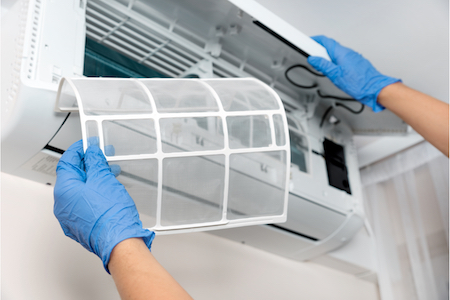
Change or Clean Air Filters
Locate the air filter in your HVAC system. It’s typically found in a return air grille or near the furnace or air handler.
- Turn off the HVAC system to ensure safety.
- If you have a disposable filter, carefully remove it from its slot. If it’s a reusable filter, follow the manufacturer’s instructions for removal.
- If using a disposable filter, check for the filter’s MERV (Minimum Efficiency Reporting Value) rating, which indicates its filtration efficiency. Choose a replacement filter with a similar or better MERV rating.
- Install the new filter, ensuring it fits snugly and the airflow direction is correct (usually indicated by arrows on the filter).
- If you have a reusable filter, remove it and clean it according to the manufacturer’s instructions. This typically involves vacuuming or rinsing the filter.
- Once the filter is replaced or cleaned, turn the HVAC system back on.
- Check the filter regularly (every 1-3 months) and replace or clean it as needed to maintain optimal air quality and system efficiency.
Check for Unusual Noises or Issues
- Listen for any unusual sounds coming from your HVAC system, such as banging, rattling, squealing, or hissing.
- If you hear unusual noises, try to pinpoint their source. It could be coming from the indoor unit (air handler or furnace) or the outdoor unit (condenser).
- Pay attention to changes in temperature and airflow. If you notice that your home is not heating or cooling properly, it could indicate an issue.
- Check for any visible leaks, such as water around the indoor unit or refrigerant leaks around the outdoor unit.
- Look for warning lights or error codes on your HVAC system’s control panel.
- If you suspect a problem or notice any of these issues, it’s advisable to contact a qualified HVAC technician for a professional inspection and repair. Addressing problems early can prevent costly repairs and system breakdowns.
Plumbing
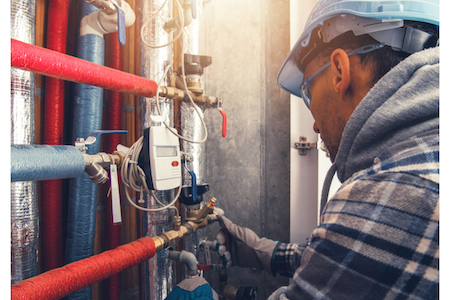
Thorough Home Plumbing Check
Giving your home’s plumbing a once-over is a smart move to avoid bigger issues down the road. First, take a look at all the faucets in your kitchen and bathrooms. Keep an eye out for drips or water gathering around the base of the faucet.
Next, peek under the sinks. Check if there’s any sign of dampness, rust, or water stains on the pipes.
In the bathroom, look at the bottom of the toilet for puddles or water rings. And don’t forget to listen for any hissing or running water sounds that could suggest a leak.
If you spot any leaks or have a hunch something’s not right, don’t delay. Tighten loose faucet connections, replace old washers, or if it’s a bigger concern, get in touch with a plumber for professional help.
Taking care of leaks right away not only saves water but also stops potential damage to your home in its tracks.
Check Water Heater for Any Signs of Problems
Locate your water heater. It’s typically in the basement, garage, utility room, or a dedicated closet.
- Look for any signs of water around the base of the water heater. Water puddles or corrosion can indicate a leak.
- Check the temperature setting on the water heater. Make sure it’s set to an appropriate temperature (usually around 120°F or 49°C) to prevent scalding and save energy.
- Listen for any unusual sounds coming from the water heater, such as popping or rumbling noises, which can be a sign of sediment buildup.
- Test the pressure relief valve by lifting the lever briefly. Be cautious, as hot water may be released. If water flows freely through the valve and then stops when you release the lever, it’s working correctly.
- Inspect the area around the water heater’s vent for any signs of rust or damage.
- If you notice any leaks, unusual noises, or other signs of problems with your water heater, it’s advisable to contact a licensed plumber or HVAC technician for a thorough inspection and necessary repairs. Neglecting water heater issues can result in energy inefficiency, water damage, or even potential safety hazards.
Safety Devices
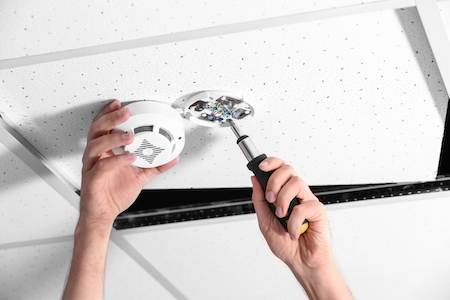
If Applicable: Test Smoke Detectors and Carbon Monoxide Alarms
- Locate all the smoke detectors and carbon monoxide (CO) alarms in your home. They are typically installed on each level of the house and in or near bedrooms.
- Press the test button on each smoke detector and CO alarm. You should hear a loud, distinct alarm sound.
- If the alarm does not sound or sounds weak, replace the batteries immediately.
- It’s recommended to test these alarms at least once a month to ensure they are in working order.
- In addition to monthly testing, replace the batteries in smoke detectors and CO alarms at least once a year, or as soon as you hear a low-battery chirp.
- If you have hardwired alarms, check the manufacturer’s recommendations for battery replacement and testing.
Maintaining Fire Safety Equipment
To ensure the safety of your home and loved ones, it’s important to regularly inspect and maintain fire safety equipment. Start by locating all fire extinguishers in your home, typically found in areas like the kitchen and garage where fires are more likely to occur.
Check the pressure gauge on each fire extinguisher and ensure the needle rests in the green zone, indicating it’s charged and ready for use. Look at the inspection tag or label for the last service date; these should undergo professional servicing every 1-3 years, depending on the type.
Ensure your fire extinguishers are easily accessible and not obstructed by furniture or clutter. Familiarize yourself with how to use a fire extinguisher, often following the PASS method (Pull, Aim, Squeeze, Sweep).
If you come across an extinguisher with low pressure or an expired inspection date, it’s wise to contact a fire extinguisher service company for maintenance or replacement.
Regularly testing smoke detectors, CO alarms, and fire extinguishers is crucial to safeguarding your home and family in emergencies.
Garbage Disposal

Cleaning and Deodorizing Your Garbage Disposal
Keeping your garbage disposal clean and odor-free is a simple yet essential task. Start by turning off the disposal and ensuring there are no items or debris inside. Plug the sink drain or use a stopper to block water from entering the disposal. Fill the sink with a few inches of warm water and add a small amount of dish soap.
With the sink stopper removed, turn on the garbage disposal and let the soapy water flow into it while it runs. This helps clean the disposal’s blades and inner surfaces effectively. After a minute or two, turn off both the disposal and the water.
For an extra boost in cleaning power and deodorizing, consider grinding some ice cubes and a few lemon or orange peels in the disposal. This step helps remove any lingering food particles and leaves a refreshing citrus scent. After grinding the ice and peels, turn off the disposal and run cold water to flush out any remaining debris.
To maintain a fresh-smelling garbage disposal, you can also pour a mixture of baking soda and vinegar down the drain. Allow it to sit for a few minutes before flushing with hot water.
This cleaning and deodorizing routine can be repeated as needed, typically once a month or whenever you detect odors emanating from the disposal. Regular maintenance ensures a pleasant kitchen environment and keeps your garbage disposal in optimal working condition.
Quarterly (Every 3 Months)
Performing home maintenance and housekeeping tasks on a quarterly basis is crucial for addressing less frequent but equally important chores that contribute to your home’s long-term well-being. This regular maintenance and cleaning routine, scheduled every three months, helps preserve your home’s structural integrity, cleanliness, and overall comfort, ultimately preventing potential problems from escalating and creating a more enjoyable living space.
Deep Cleaning
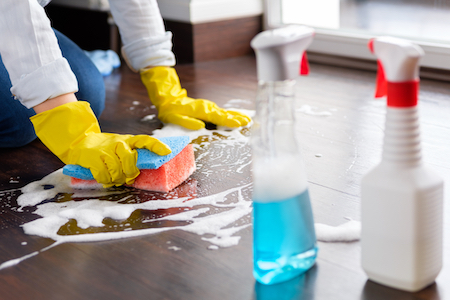
Efficiently Dusting and Cleaning All Surfaces
Efficiently cleaning your home surfaces starts with preparation.
Remove any clutter or items from the surfaces you intend to clean. Then, begin the cleaning process by dusting all surfaces using a microfiber cloth or a duster.
Work your way from top to bottom to prevent dust from settling on lower surfaces.
For hard surfaces such as countertops, tables, and shelves, utilize a mild all-purpose cleaner along with a clean cloth to wipe them down thoroughly. Pay close attention to frequently touched areas like doorknobs, light switches, and remote controls.
Additionally, don’t overlook dusting and cleaning baseboards, moldings, and ceiling fans if they are present in your home.
To complete the cleaning routine, vacuum or sweep the floor after dusting to capture any fallen dust and debris, leaving your living space looking fresh and pristine.
Cleaning Windows and Window Coverings Made Easy
When it comes to cleaning your windows, a few simple steps can leave them looking crystal clear.
Start by dusting or vacuuming window sills and frames to remove any loose dirt and debris. For window coverings such as blinds or curtains, consult the manufacturer’s instructions for cleaning, which may involve dusting, vacuuming, or washing.
For the window glass itself, you can create an effective cleaning solution using glass cleaner or a mixture of water and vinegar. Spray the cleaning solution onto the glass and use a lint-free cloth or paper towels to wipe it clean, leaving no streaks or residue behind.
Don’t forget to clean both sides of the windows, especially if they are easily accessible from the inside. With these steps, you can achieve sparkling, clear windows that let the light shine in and offer a beautiful view of the outside.
Cleaning Refrigerator Coils
- First, unplug the refrigerator or turn off the power at the circuit breaker for safety.
- Locate the coils, which are usually on the back of the fridge or beneath it.
- Use a refrigerator coil brush or a vacuum cleaner attachment to gently remove dust and debris from the coils.
- Be careful not to damage the coils while cleaning.
- After cleaning, plug the refrigerator back in or restore power.
Cleaning Oven and Microwave
- For the oven, remove the racks and any loose crumbs or debris.
- Follow the manufacturer’s instructions for using an oven cleaner or a natural solution like baking soda and water to clean the interior. Scrub away any burnt-on residue.
- Wipe down the oven door and handle with a damp cloth.
- For the microwave, remove any removable parts like the turntable and wash them separately.
- Use a microwave-safe bowl filled with water and a few slices of lemon or vinegar to steam clean the interior. This helps loosen food splatters.
- Wipe down the interior with a damp cloth or sponge.
- Don’t forget to clean the microwave exterior, including the control panel and keypad.
Regularly cleaning these areas helps maintain a clean and healthy living environment in your home.
Plumbing
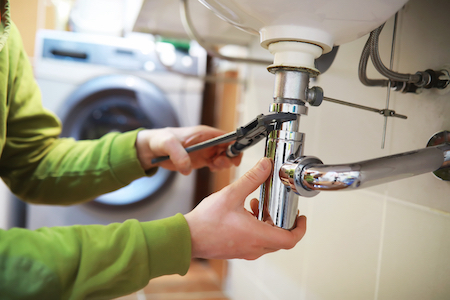
Inspect for Leaks Under Sinks
- First, gather your trusty flashlight and some paper towels or a cloth.
- Crouch down under the sink and take a good look around. Shine your flashlight on all the pipes, connections, and the base of the sink cabinet.
- Check for any signs of moisture, water stains, or puddles. If you spot anything suspicious, use the paper towels or cloth to dry the area and identify the source of the leak.
- Tighten any loose connections, like the nuts on the pipes, if that’s the issue. If the problem persists or seems serious, it’s time to call a plumber to fix it.
- Repeat this inspection regularly, especially if you live in an older home or notice any changes in water pressure or unusual odors.
Check Water Softener Salt Levels (if applicable)
- Locate your water softener system, which is typically in the basement or utility room.
- Open the lid or access panel to reveal the salt reservoir.
- Using a scoop or a funnel, add salt to the reservoir if it’s running low. Be sure to use the type of salt recommended by the manufacturer, which is usually specific water softener salt pellets or blocks.
- Avoid overfilling, as this can cause issues with the system.
- Close the lid or access panel securely.
- Depending on your water usage and the size of the water softener, you may need to check and replenish the salt every few weeks to a few months.
Regularly inspecting for leaks under sinks and maintaining proper water softener salt levels (if you have a water softener) can help prevent water damage and ensure the continued effectiveness of your plumbing systems.
Biannually (Every 6 Months)
Ensuring biannual home maintenance is a crucial habit, providing opportunities for in-depth inspections and essential upkeep, effectively protecting your home from potential issues and maintaining its safety, comfort, and value.
Appliances
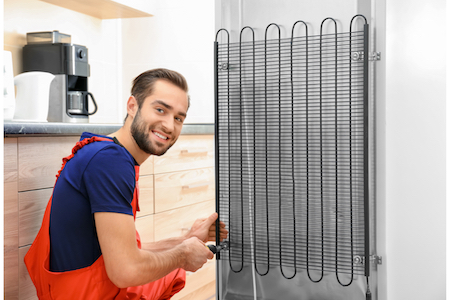
Vacuum Refrigerator Coils
- Unplug your refrigerator or turn off the power at the circuit breaker.
- Locate the coils, usually at the back or beneath the fridge.
- Use a vacuum cleaner with a brush attachment to gently remove dust and debris from the coils.
- Ensure you’ve cleaned thoroughly, then plug the refrigerator back in or restore power.
- This improves cooling efficiency and prolongs the fridge’s life.
Check and Clean Dryer Vents
- Start by unplugging your dryer or turning off the gas supply.
- Remove the lint filter and clean any lint or debris from it.
- Check the vent hose behind the dryer for lint buildup. Disconnect it if necessary and clean both the hose and the vent opening.
- Vacuum the area behind the dryer and the vent pipe.
- Reconnect everything, plug the dryer back in or turn on the gas, and run a test cycle.
- Regular vent cleaning reduces fire hazards and enhances dryer efficiency.
Electrical
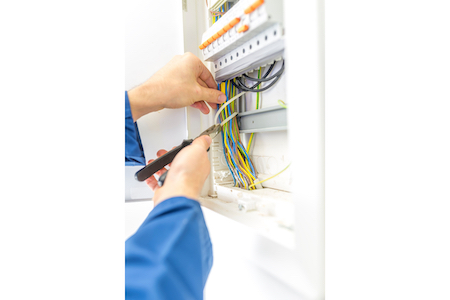
Test GFCI Outlets
- Locate the GFCI outlets in your home, typically found in areas like kitchens, bathrooms, and outdoor spaces.
- Press the “Test” button on the GFCI outlet to simulate a ground fault.
- The GFCI should trip, cutting off power to the outlet. You’ll hear a click and the “Reset” button will pop out.
- Press the “Reset” button to restore power. If it doesn’t reset, or if the outlet doesn’t trip when you press “Test,” it may be faulty and should be replaced.
- Regular testing ensures GFCI outlets are functioning correctly, providing shock protection.
Inspect Electrical Cords for Damage
- Examine all electrical cords and plugs in your home, including those on appliances, lamps, and devices.
- Look for any visible signs of damage, such as frayed wires, exposed conductors, or cracked insulation.
- If you find damaged cords, discontinue use immediately and replace them. Do not attempt to repair damaged cords as it can be hazardous.
- Make sure cords are not pinched or damaged by furniture or heavy objects.
- Regular inspections prevent electrical hazards and ensure safe use of electrical devices.
Caulking and Sealing
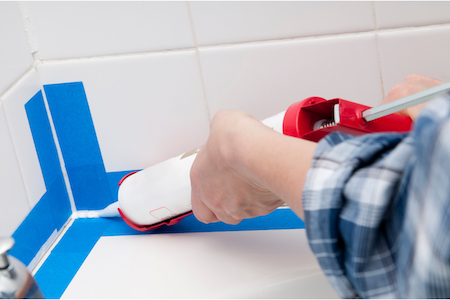
Inspect and Re-caulk Areas in Bathrooms and Kitchens (as Needed)
- Regularly check the caulk around sinks, bathtubs, showers, and kitchen countertops.
- Look for signs of wear, cracking, or gaps in the caulk.
- If you notice any damage or deterioration, it’s time to re-caulk.
- To re-caulk, start by removing the old caulk using a caulk removal tool or a utility knife.
- Clean and dry the area thoroughly before applying new caulk.
- Choose a high-quality silicone or acrylic caulk that is suitable for wet areas.
- Apply the new caulk in a smooth, even bead, and use a caulk smoothing tool or your finger to create a neat finish.
- Allow the caulk to dry and cure as per the manufacturer’s instructions.
- Re-caulking prevents water damage and keeps your bathroom and kitchen areas looking fresh and clean.
Annually
Roof and Gutters
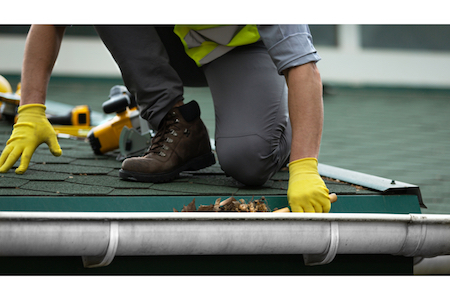
Inspect Roof for Damage or Missing Shingles
Regularly inspecting your roof is a vital part of home maintenance that can help you identify potential issues before they escalate.
Begin by carefully examining your roof for visible damage, such as cracked or curled shingles, or any areas where shingles may be missing.
If necessary, use binoculars to safely inspect the roof from the ground.
Should you discover any problems during your inspection, it’s advisable to consider hiring a professional roofing contractor for a comprehensive assessment and necessary repairs.
Regular roof inspections play a crucial role in detecting problems early, ultimately preventing water damage to your home and ensuring the longevity of your roof.
Maintaining Clean and Functional Gutters
Taking care of your gutters and downspouts is a crucial part of home maintenance, especially when it comes to protecting your home’s foundation from water damage. Start by clearing debris from the gutters, including leaves, twigs, and dirt. You can use a gutter scoop or your hands (wearing gloves is a good idea).
After removing the debris, ensure proper water flow by flushing the gutters with a garden hose. This step helps clear any remaining particles and ensures smooth drainage. While you’re at it, inspect the gutters and downspouts for any damage or clogs. Keep an eye out for signs of rust, sagging, or loose connections.
In case you encounter clogs in the downspouts, you can use a plumber’s snake or a hose to clear them out. If you identify any damage, it’s essential to make prompt repairs to the gutters or downspouts to maintain their functionality. Regular gutter maintenance is a preventive measure that not only prevents water overflow but also safeguards your home’s foundation from potential water damage.
Foundation
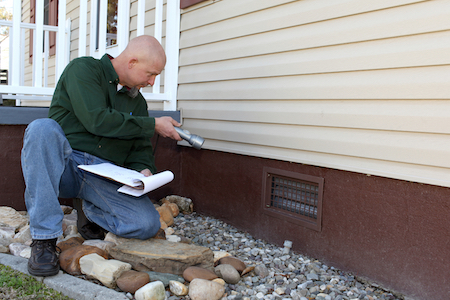
Foundation Inspection for Structural Health
Maintaining a sturdy foundation is essential for the structural integrity of your home.
Start by visually inspecting the exterior foundation walls, including any accessible areas like the basement or crawl space. Look closely for any visible cracks, both horizontally and vertically, in the foundation walls, and take note of any cracks wider than a quarter-inch.
Additionally, check for signs of settling, which may manifest as uneven floors, doors or windows that no longer close properly, or gaps between the foundation and the rest of the structure. If you observe significant cracks or signs of settling, it’s wise to seek the expertise of a foundation specialist or structural engineer for a professional assessment.
Regular inspections are a proactive way to identify foundation issues early on, helping you prevent potential structural problems and the costly repairs that may arise if these issues are left unaddressed.
HVAC System
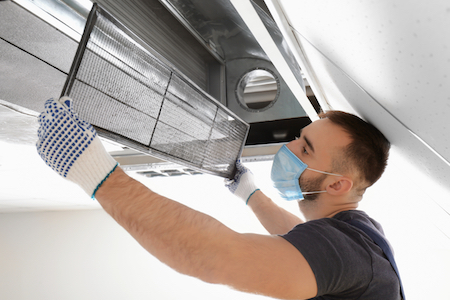
Schedule Professional Maintenance and Cleaning
Regularly scheduling professional maintenance and cleaning services for your home’s HVAC (Heating, Ventilation, and Air Conditioning) system is a wise move.
These services include inspecting and tuning up your heating and cooling systems to ensure they function optimally.
Hiring qualified HVAC technicians ensures that your home’s climate control systems are in top shape, reducing the chances of unexpected breakdowns or inefficient operation. It’s advisable to schedule these services annually or follow the recommendations provided by HVAC equipment manufacturers or service providers.
By prioritizing HVAC system maintenance, you not only keep your home comfortable year-round but also save on energy costs and extend the lifespan of your heating and cooling equipment. A well-maintained HVAC system is not only efficient but also environmentally friendly.
Check Ductwork for Leaks and Insulation
Maintaining the efficiency of your HVAC system involves inspecting and tending to your ductwork. Start by checking the visible sections of your ductwork for any telltale signs of leaks, gaps, or damage. If you spot any issues, promptly seal them with duct tape or mastic sealant to prevent energy loss.
Additionally, make sure your ducts are adequately insulated to minimize heat loss or gain within your home. You can enhance insulation by using insulation sleeves or wrap.
Properly sealed and insulated ducts play a pivotal role in improving HVAC efficiency, ensuring that your home maintains a comfortable indoor environment while saving on energy costs.
To keep your ductwork in top shape, consider periodic professional duct cleaning and inspections.
Chimney and Fireplace: (For colder areas like in Baguio or Tagaytay)
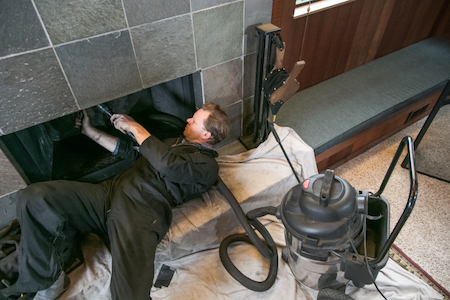
Schedule Chimney Cleaning and Inspection
Ensuring the safety and efficiency of your fireplace or wood-burning stove involves planning an annual chimney cleaning and inspection.
To carry out this essential task, it’s wise to enlist the expertise of a certified chimney sweep or a professional chimney service.
During the inspection, the technician will meticulously examine your chimney for several critical factors, including the presence of creosote buildup, blockages, and any structural damage.
Creosote, a flammable substance that can accumulate within chimneys, poses a significant fire hazard, making its removal imperative.
By adhering to this regular maintenance schedule, you not only mitigate the risk of chimney fires but also ensure proper ventilation, creating a safer and more enjoyable atmosphere within your home. Fireplace safety is paramount, and these annual inspections play a pivotal role in maintaining it.
Pest Control

Schedule a Professional Pest Inspection or Treatment (if Needed)
Guarding your home against unwanted pests is essential for a comfortable and safe living environment.
Regularly assess your property for any signs of pests, whether it be rodents, insects, or other critters that may have taken up residence.
If you do spot pests or signs of an infestation, it’s advisable to schedule a professional pest inspection promptly. Pest control experts can not only identify the type and extent of the infestation but also recommend appropriate treatment measures.
However, prevention is the best course of action. Even if you don’t currently see pests, consider annual inspections to catch any potential issues early on.
Addressing pest problems promptly not only protects your home but also ensures that it remains a pest-free haven for you and your family.
Driveway and Walkways
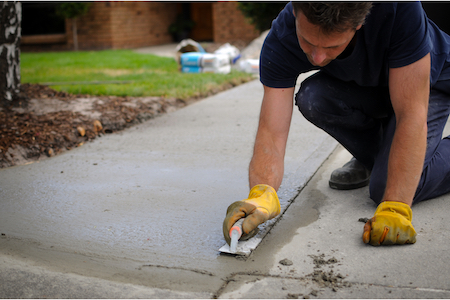
Repair Any Cracks or Damage
Maintaining your home’s exterior includes regularly inspecting your driveway and walkways for signs of wear and tear, such as cracks, potholes, or other forms of damage. For small cracks, you can easily remedy the situation by applying a concrete patching compound to fill them.
However, when it comes to larger or more extensive damage, it may be necessary to seek the assistance of a professional for repair or resurfacing. Properly maintained driveways and walkways not only enhance the curb appeal of your home but also ensure the safety of those who traverse them.
By addressing these issues early on, you prevent them from worsening, ultimately saving you both time and money while preserving the overall aesthetic and safety of your property.
Landscaping
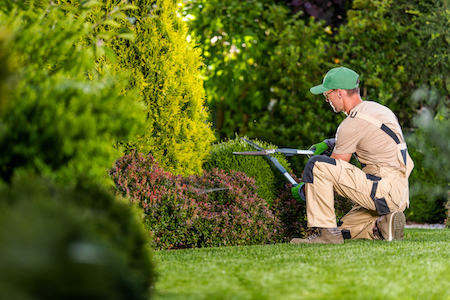
Prune Trees and Shrubs
- Prune trees and shrubs during the appropriate season, typically in late winter or early spring before new growth starts.
- Remove dead or diseased branches and trim for shape and size control.
- Proper pruning promotes healthy growth, prevents overgrowth, and enhances the appearance of your landscape.
Fertilize and Aerate the Lawn
Achieving a lush, green, and healthy lawn involves a few key steps.
To start, apply a suitable fertilizer to your lawn in the early spring and late fall, following the recommended application rates. This ensures your grass receives the necessary nutrients for robust growth.
Another vital aspect of lawn care is aeration, which involves perforating the soil with small holes to facilitate the penetration of nutrients, water, and air deep into the ground. Typically, aeration should be performed once a year, either in the fall or spring, to maintain soil health and optimal nutrient uptake.
Regular lawn maintenance not only keeps your outdoor space looking its best but also contributes to the overall well-being of your lawn. With proper aeration and fertilization, you’re well on your way to enjoying a vibrant, thriving lawn that enhances your home’s beauty and value.
Exterior Paint
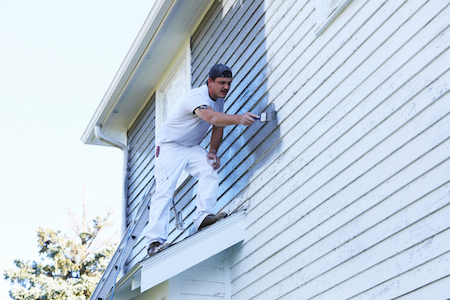
Inspect and Touch Up Exterior Paint as Needed
Preserving the beauty and value of your home involves periodic inspections of its exterior.
Look for signs of paint damage, such as peeling, cracking, or fading, paying special attention to areas exposed to the elements, such as trim, siding, and windowsills.
When you discover damaged or deteriorating paint, it’s time for some touch-up work. Start by carefully scraping off loose or peeling paint, followed by sanding to create a smooth surface. If necessary, apply a primer, and then repaint the affected areas using the same or a matching paint color.
Regularly maintaining your home’s exterior paint not only shields it from weather-related wear and tear but also prolongs its lifespan. This essential upkeep enhances your home’s appearance, protecting its value and curb appeal for years to come.
Water Heater
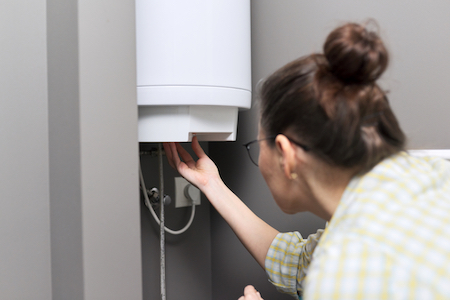
Drain and Flush the Water Heater to Remove Sediment
- Turn off the power supply to the water heater, either by switching off the breaker or shutting off the gas supply.
- Close the cold water inlet valve leading to the water heater to prevent new water from entering.
- Attach a hose to the drain valve located near the bottom of the water heater and place the other end in a suitable drainage location, like a floor drain or a bucket.
- Open a hot water faucet in your home to allow air to enter the system, which helps with draining.
- Carefully open the drain valve on the water heater, allowing the hot water and sediment to flow out through the hose.
- After draining, close the drain valve and remove the hose.
- Turn on the cold water inlet valve to fill the tank.
- Once the tank is full, turn on the power supply or gas to the water heater.
- Regularly draining and flushing your water heater removes sediment, improves efficiency, and extends the appliance’s lifespan. It also ensures you have access to clean, hot water.
Attic and Basement
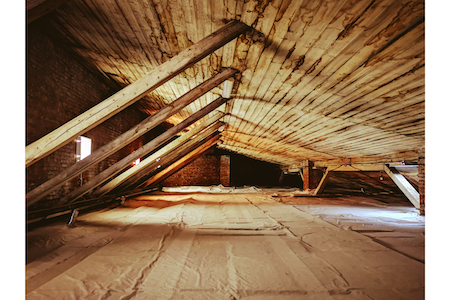
Inspect for Leaks, Moisture, and Insulation
Effective moisture management in your home’s basements and attics is crucial for maintaining a healthy and well-maintained living space.
Periodically check these areas, especially after heavy rain for signs of leaks or excess moisture. Be vigilant for water stains on walls, ceilings, or floors, and watch out for damp spots or musty odors, which may indicate underlying issues.
In addition to these visual checks, inspect the insulation within your basements and attics for any damage or gaps that could compromise the energy efficiency of your home. Ensure that vents and exhaust systems are in proper working order to prevent moisture buildup.
Address any leaks or moisture problems promptly to prevent potential water damage and the growth of mold. Adequate insulation in basements and attics not only contributes to maintaining a comfortable indoor environment but also supports energy efficiency in your home.
Regular inspections of these critical areas are essential to keep your living space in top condition, ensuring that your home remains a comfortable and safe haven for you and your loved ones.
Remember that this is a general guideline, and your specific home may have additional maintenance needs based on its age, location, and unique features. Regular upkeep is essential for maintaining the value and comfort of your home.
In the journey of homeownership, one thing becomes abundantly clear: maintaining your home is not just an option; it’s a necessity. Whether it’s the routine chores like cleaning, the occasional repairs, or the periodic inspections, every aspect of home maintenance plays a vital role in preserving your property’s beauty, functionality, and value.
The frequency of these tasks cannot be overstated. By proactively addressing issues on a regular basis, you prevent them from spiraling into costly and time-consuming problems down the road. From the smallest crack in the driveway to the annual HVAC check-up, each task contributes to the overall health and longevity of your home.
Moreover, consistent home maintenance fosters a safe and comfortable living environment for you and your family. It ensures that your home remains a place of comfort, security, and pride. It also safeguards your investment, ensuring that your property appreciates in value over time.
In the grand tapestry of homeownership, the threads of routine maintenance are the foundation. They weave together to create a space where memories are made, where dreams are nurtured, and where life unfolds. So, embrace the rhythm of home maintenance, and let it be the key to unlocking a future filled with comfort, joy, and lasting value.
Frequently Asked Questions (FAQs) – Housekeeping and Home Maintenance
- What is housekeeping?
- Housekeeping is the practice of cleaning, organizing, and maintaining a home to ensure it is neat, hygienic, and comfortable.
- How often should I clean my house?
- The frequency of cleaning depends on factors like the size of your home, the number of occupants, and personal preferences. Generally, daily tasks and weekly deep cleaning are recommended.
- What are the essential housekeeping supplies?
- Common housekeeping supplies include cleaning agents, brooms, mops, vacuum cleaners, dusters, and microfiber cloths.
- How can I make housekeeping more efficient?
- Creating a cleaning schedule, decluttering regularly, and using organizational tools can streamline housekeeping tasks.
- What are some eco-friendly housekeeping practices?
- Eco-friendly practices include using natural cleaning products, reducing water and energy usage, and recycling or repurposing items.
Frequently Asked Questions (FAQs) – Housekeeping and Home Maintenance
General Housekeeping FAQs:
- What is housekeeping?
- Housekeeping is the practice of cleaning, organizing, and maintaining a home to ensure it is neat, hygienic, and comfortable.
- How often should I clean my house?
- The frequency of cleaning depends on factors like the size of your home, the number of occupants, and personal preferences. Generally, daily tasks and weekly deep cleaning are recommended.
- What are the essential housekeeping supplies?
- Common housekeeping supplies include cleaning agents, brooms, mops, vacuum cleaners, dusters, and microfiber cloths.
- How can I make housekeeping more efficient?
- Creating a cleaning schedule, decluttering regularly, and using organizational tools can streamline housekeeping tasks.
- What are some eco-friendly housekeeping practices?
- Eco-friendly practices include using natural cleaning products, reducing water and energy usage, and recycling or repurposing items.
- What is home maintenance?
- Home maintenance refers to the regular tasks and repairs needed to keep a house in good condition, ensuring safety, functionality, and longevity.
- How often should I perform home maintenance?
- Home maintenance frequency varies but includes daily, weekly, monthly, quarterly, and biannual tasks. Specific schedules depend on the task and season.
- What are the most important home maintenance tasks?
- Critical tasks include checking for leaks, inspecting the roof and foundation, servicing HVAC systems, cleaning gutters, and maintaining safety features like smoke detectors and fire extinguishers.
- Is professional home maintenance necessary, or can I do it myself?
- While some tasks can be DIY, professionals should handle others. It’s essential to know your capabilities and seek help when required.
- How can I prevent home maintenance issues from becoming costly problems?
- Regular inspections and addressing issues promptly can prevent minor concerns from escalating. Following a maintenance schedule is key.
- How can I effectively clean different types of flooring?
- Cleaning methods vary for carpet, hardwood, tile, and other types of flooring. Consult manufacturer recommendations for best practices.
- What are some tips for efficient and organized cleaning?
- Prioritize tasks, use a checklist, and establish a cleaning routine to improve efficiency.
- What should I do to maintain my HVAC system?
- Regularly change air filters, clean vents, and schedule professional inspections to ensure your HVAC system functions efficiently.
- How can I prevent mold and mildew in my home?
- Proper ventilation, managing humidity levels, and addressing water leaks promptly can prevent mold and mildew growth.
These FAQs provide a starting point for understanding housekeeping and home maintenance. Remember that specific situations may require tailored solutions, so consult experts when necessary.
